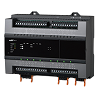Thermal Storage
Thermal storage is storing thermal energy. There are two types of thermal storage, one for cooling (used for air onditioners, refrigerators, etc.) and the other for heating (used for hot water supply, etc.). With thermal storage, the required heat or cold is available when it is needed.
- Three benefits of thermal storage
- Chilled water at night to use for an HVAC system the next day
- For more efficient use of thermal energy

Three benefits of thermal storage
Thermal storage literally means storing heat energy. When you hear “thermal,” a high temperature may come to mind, but “thermal storage” applies to both heat and cold.
A gel pack (ice pack) that is included in the box with cake or perishable food is an example of thermal storage for cooling. The risk that food quality will deteriorate increases at room temperature, but a gel pack will prevent the temperature in the box from rising. Various benefits like this can be obtained from thermal storage. It has three main benefits.
First, thermal energy can be used when necessary. If you store gel packs, you can use them anytime you want, the same way that you can use the ice in the freezer for cooling.
Second, thermal storage allows you to use a large amount of heat or cold at one time. The amount of ice that can be made in an ice tray is limited, but if you store the ice in a chest freezer you can use a large amount of ice at the same time.
Put another way, you don’t need a lot of ice trays if you have a chest freezer for storing ice. This is the third benefit. Using thermal storage, less equipment is needed for generating heat or cold.
These three benefits are also true of thermal storage for heating. For example, in buffets, insulated coffee pots are used. With such pots, a large amount of coffee can be prepared for use at one time even if there are not so many coffeemakers, and customers can drink hot coffee any time.
Chilled water at night to use for an HVAC system the next day
Thermal storage mechanisms are also used on a large scale. A typical example is an HVAC system with thermal storage.
In large buildings, the thermal energy for cooling in summer and heating in winter is generated by the central plant equipment. For HVAC systems with thermal storage, there is central plant equipment that generates thermal energy, HVAC equipment that uses the thermal energy, and a thermal storage tank for storing the thermal energy. This storage tank stores thermal energy in the same way that a chest freezer or insulated coffee pot does, contributing to the efficient use of energy.
A storage tank filled with water is a common example of a thermal storage tank. The water in the thermal storage tank is cooled using electricity at night, and the next day it is used by the central plant equipment, and it can be used by the air conditioning so that a large amount of cooling can be produced with a small amount of equipment. The water in the tank can also be used in case of fire or for other daily living needs. This is one of the benefits of storing water in a tank.
This same mechanism can be used for heating, but it is not as efficient as for cooling because recent buildings have good thermal insulation that prevents the room temperature from dropping easily.
For more efficient use of thermal energy
In addition to thermal storage tanks, the building’s skeleton can provide thermal storage. Here is an example when air conditioning is used in the summer. The walls and floors of a building are cooled by the air conditioning, so you may feel cool for a while even after the HVAC system is turned off. This is an effect of thermal storage by the frame of the building. As in the case of a thermal storage tank, the frame of the building can be cooled at night when the demand for electricity is low, in order to reduce the amount of energy consumption during the day.
The reasons for doing so are the following: there are plans with less expensive electricity rates at night,; energy consumption during the day, when society needs energy the most, can be reduced (helping to even out the usage of energy); and the equipment can operate more efficiently at night.
During the day, according to how the air conditioning is used, the central plant equipment adjusts its performance, so its efficiency may drop correspondingly. In contrast, at night, the air conditioning load is low, and the equipment can operate in the most efficient way in order to cool the thermal storage tank. In addition, since the outside temperature is lower at night, less energy is required to lower the temperature to the same level, resulting in high overall energy efficiency.
As we have seen, in order to use thermal storage for HVAC purposes, preparation on the previous day is important. If the next day will be hot, it is not possible to suddenly increase the amount of thermal storage. Also, if the amount of storage for cooling is more than what is needed, the energy used to cool the storage medium will have been wasted.
For this reason, research is underway to develop simulations for thermal storage demand forecasting. By combining data on the weather, building usage, and air conditioning usage in the past, the relationship between weather and the demand for stored thermal energy can be modeled, and the required amount of thermal energy can be calculated by using the model with the weather forecast for the next day. Various efforts like this are being made for the efficient use of energy and facilities.

